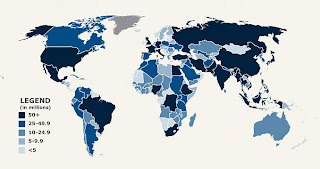1804 1 billion
1927 2 billion
1960 3 billion
1974 4 billion
1987 5 billion
1999 6 billion
2011 7 billion
2025 8 billion
2045 9 billion
From 1804 to 1927 (123 years) world population doubled
From 1927 to 1974 (47 years) world population doubled
From 1960 to 1999 (39 years) world population doubled
From 1974 to 2025 (51 years) world population is expected to double
World population needs to be stabilized quickly and high consumption in rich countries rapidly reduced to avoid "a downward spiral of economic and environmental ills", warns a major report from the Royal Society.
Contraception must be offered to all women who want it and consumption cut to reduce inequality, says the study published on Thursday, which was chaired by Nobel prize-winning biologist Sir John Sulston.
The assessment of humanity's prospects in the next 100 years, which has taken 21 months to complete, argues strongly that to achieve long and healthy lives for all 9 billion people expected to be living in 2050, the twin issues of population and consumption must be pushed to the top of political and economic agendas. Both issues have been largely ignored by politicians and played down by environment and development groups for 20 years, the report says.
"The number of people living on the planet has never been higher, their levels of consumption are unprecedented and vast changes are taking place in the environment. We can choose to rebalance the use of resources to a more egalitarian pattern of consumption ... or we can choose to do nothing and to drift into a downward spiral of economic and environmental ills leading to a more unequal and inhospitable future", it says. Read more
What kinds of issues might we have when our world becomes over-populated? But, before we make our list, let’s look at the population map below and see what countries will be affected.
 |
| Click to enlarge |
As we can see those countries in harm’s way are: America, Canada, Central America, South America, Africa, Europe, Eastern Europe, Russia, China, India, Middle East, Far East…
Just about every country in the world…
Seems rather amazing to me!
So, our concerns could be:
- Housing
- Water & Sewage
- Food & Farming
- Healthcare
- Clothes
- Police Protection
- Jobs
- Other Resources… so, what do I mean by this? Well,
PARIS — The world's 16 largest power grids need to invest $700 billion over the next 10 years to cope with a rising share of renewable energy in mature economies and with soaring demand in emerging nations, French power grid RTE said.
The 16 grids, which transport 70 percent of the world's electricity demand, expect global demand to jump 50 percent by 2022, when renewable energy will equal the capacity of 250 medium-sized nuclear reactors.
"In North America and in Europe, the need for investment is a necessity to connect dozens of thousands of megawatts of solar and wind power," Dominique Maillard, head of RTE, said in an interview on the sidelines of a meeting of the GO 15 lobby, which unites grid operators from the United States, South Africa, China, France and other countries.
The operators, which operate nearly 1.4 million miles of transmission lines, say grids will need to be enhanced to ensure the safe connection and transport of renewable energy.
"If we don't succeed in developing networks properly, either the energy transition will remain a pretty expression that was never applied, or we will run the risk of living dangerously," Maillard said, referring to a heightened risk of blackouts.



No comments:
Post a Comment